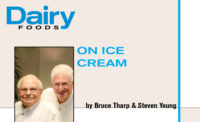
Sherbet, water ices and sorbets can very well be forgotten or misunderstood. Often, they sit in the shadow of classical standardized ice creams or even non-standard frozen desserts (for example, frozen yogurt, non-dairy foods, generic frozen dairy desserts, etc).
However, demands on new product development, new flavors, innovative applications and approaches, cost reduction or cost avoidance make these frozen dessert workhorses more capable of meeting consumer needs and preferences. They fill voids that ice creams and other products simply may not be able to. Given this, the value of sherbets, water ices and sorbets to any given product line cannot be understated.
The properties of sherbet
Sherbet is a frozen dessert that, compared to ice cream, has much lower levels of fat (1-2%), milk solids not fat (2-4%, all of which can be whey solids), lower overrun (minimum weight 6 pounds per gallon) and higher levels of sweetener (typically 28-32%). See the table for a comparison of sherbet to sorbets and water ices.
Sherbet can be produced in any flavor; however, fruit flavors are predominate. In fruit flavors, organic acids are added to enhance flavor - a level of acidity of at least 0.35% (calculated as lactic acid) is required by the Food and Drug Administration’s Standard of Identity. The standard also includes minimum requirements for the quantity of fruit: citrus - 2%; berries - 6%; and other fruits - 10%.
The body and texture properties of sherbets range from the traditional icy, cold style to a smooth, creamy product with a mouthfeel close to that of ice cream. Initially, sherbet was considered to be a refreshing frozen dessert, particularly appropriate for consumption during warm seasons. Its refreshing qualities were provided by a dense, low overrun structure that provided more mass per spoonful than ice cream and, therefore, more cooling effect.
The inclusion of typical ice cream emulsifier systems and advanced stabilizers make it possible to produce a sherbet with eating properties more like those of ice cream. Emulsifiers produce stronger, more stable and smaller air bubbles that add to creaminess, while alternative stabilizer systems provide enhanced control over ice crystal growth.
It is now possible to produce sherbet products over a broad range of properties, including the achievement of overrun in the normal ice cream range. Such products would fall below the weight limitations of the standard of identity; however, they would have legal acceptance if identified by a fanciful name other than “sherbet.” If properly formulated, more mainstream flavors may be possible, thus, compounding the subtle differences between “sherbet” and ice cream.
Water ice goes upscale
Water ices are frozen desserts that consist of mainly water, sweetener, acidulant, flavor, color and stabilizer. They can be considered as sherbets in which no dairy ingredients are present. They are sometimes produced as quiescently frozen novelties. They may or may not have added air whipped into them and may or may not have added emulsifiers as well. If air is whipped into the mix, special formulation considerations are necessary.
Sorbet is marked by fruit solids
No regulatory definition for “sorbet” exists. Thus, it is conventional wisdom that defines it as an upscale water ice. The basis for the upscale characterization is the added quality that comes from the fact that products identified as sorbet usually derive at least part of their sweetening from bland fruit juice concentrates (often apple or pear), fruit juice concentrates of the select characterizing flavor (e.g., strawberry) and often contain discrete fruit pieces. As a result, sorbet contains more fruit solids than water ice (which usually has none). The overrun level in sorbet is generally less than 15-25%.
Bruce Tharp is principal of Tharp’s Food Technology, Wayne, Pa. Steve Young is principal of Steven Young Worldwide, Houston.
Understanding Frozen Desserts
For more on the nuances between frozen dessert types and the opportunities that are possible when considering sherbets, water ices and sorbets, join Bruce Tharp and Steven Young at their Tharp & Young On Ice Cream Technical Short Course, Workshops and Clinics, Nov. 30-Dec. 2, in Las Vegas. Course size is limited and tuition discounts are available. Go to www.onicecream.com or call 610-975-4424 or 281-782-4536.


